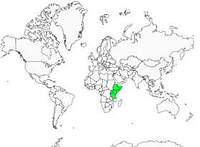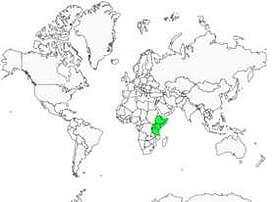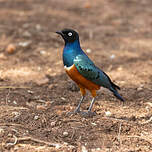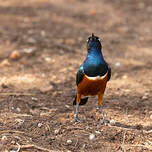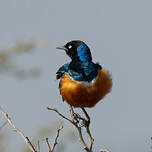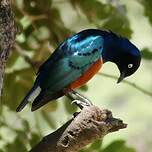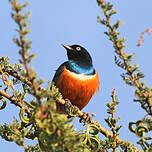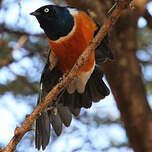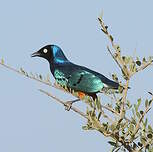Superb Starling
Lamprotornis superbus - Choucador superbe
Identification
When you see a Superb Starling, the first thought that comes to mind, as its name suggests, is it is gorgeous! Indeed, it has superb colors that are identical in the male and female. Sexual dimorphism is nonexistent, although in captivity it has been observed that the male can have a white breast band wider than the female's. The adult has a black cap covering the crown, the parotids, the cheeks and the throat, on which the white eye stands out strongly. Beyond, the change of color is sharp and spectacular. The nape, mantle and upper chest are of a deep blue fading to turquoise at the back. The wings are of an iridescent green with black spots on the coverts. The rectrices are of a blue reminiscent of the back's feathers color. Light playing can bring out different shades such as pink at the tip of the primary remiges or on the rectrices. The base of the chest, the belly and the flanks are bright orange. A white breast band separates the blue and orange of the chest. The undertail and underwing coverts are white. The legs and beak are black. The white iris, a characteristic shared with other members of the group, and the white breast band distinguish it from its cousins, the Hildebrandt and Shelley Starlings, which have a red iris and which it can come across. Juveniles resemble adults, but their plumage is duller, devoid of shininess. In addition, the iris is dark, the base of the beak is pale and the legs are brown. The first moult, the post-juvenile moult, occurs at 4 months. The iris remains dark until the next full moult of the bird, at around 1 year.
Subspecific information monotypic species
Foreign names
- Choucador superbe,
- Estornino soberbio,
- estorninho-soberbo,
- Dreifarben-Glanzstar,
- pompás fényseregély,
- Driekleurige Glansspreeuw,
- Storno superbo,
- brunbukig glansstare,
- Praktstær,
- liskavec pestrý,
- leskoptev nádherná,
- Trefarvet Glansstær,
- loistokottarainen,
- estornell superb,
- błyszczak rudobrzuchy,
- Трёхцветный спрео,
- ツキノワテリムク,
- 栗头丽椋鸟,
- brunbukig glansstare,
- 栗頭麗椋鳥,
Voice song and call
The song of the Superb Starling is composed of short but melodic stanzas (5 to 7 syllables), which are repeatedly uttered. Both adults may sing it, though the male is usually the main singer. It is emitted from a tree in the middle of the day. The most preferred singing post is a clear yet shaded branch.
Habitat
Behaviour character trait
The Superb Starling is a very common bird. It is often seen in groups since it is gregarious outside of the breeding season.
It feeds on the ground, often near cattle or wild herbivores, and never far from trees. Groups gather in roosts for the night, composed of a dozen individuals in cities to thousands of birds in the bush. It does not fear humans, on the contrary, and takes advantage of their presence. Since it is frequent around lodges and campsites and its plumage is very attractive, it is a highly appreciated bird by tourists.Dietfeeding habits
The Superb Starling is an insectivore. Its food consists of insects such as termites, flies, ants, grasshoppers, and mantis, lepidopteran and coleopteran larvae. It forages for these insects by walking the ground in small groups. It can also feed on fruits and berries as well as the nectar of agave sisalana flowers. In addition to this "natural" diet, it won't hesitate to finish the meals of tourists or village folk in populated areas.
Reproduction nesting
The Superb Starling is monogamous but a female can pair with two or more males of the same or different group.
Unpaired males offer assistance to existing pairs, such as the supply of nesting materials, in building, and/or in the feeding of the young. The breeding season is variable depending on the region, with no set period. The Superb Starling's nest is a dome-shaped construction made of a large framework of twigs edged with dry grass with a well-protected entrance on the side, located between 1.5 to 6 metres high in a thorny tree. It can also be found in tree hollows and within crevices of cliffs. The interior is lined with feathers. Thorns are deliberately laid by adults around the nest when not in a thorny tree. In some cases pairs move into White-headed (Dinemellia dinemelli) Alecto's nests after having ejected the eggs of the latter. In Tanzania, cases of nested have been found in Red-billed (Bubalornis niger) and Red-tailed (Histurgopses ruficauda) Histurgopses nests. In revenge, the Superb Starling's nest can be parasitized by the Greater Clapper (Clamator glandarius). The eggs are dark blue and in uniform, measuring 18 to 24 mm, and weighing 4.5 g. The female will generally lay 4 eggs, most likely incubated by both adults for 12 to 14 days. The young are primarily fed by parents and their helpers with insects and some berries may be added to the young's diet. They become fledglings 17 to 25 days after hatching, and remain dependent on adults and the group for 4 to 7 weeks.Geographic range
Threats - protection
IUCN conservation status
concern
in the Wild
threatened
evaluated
The Superb Starling is widely distributed and common. To this day the species is not threatened. It is difficult, however, to predict the evolution of its populations since the impact of climate change and habitat alteration on the bird is unknown.
Sources of information
- IOC World Bird List (v14.2), Gill, F and D Donsker (Eds). 2024-04-18.
- Starlings and Mynas, FEARE Chris
- BirdLife International, BirdLife International
- Wikipedia (English version),
Other sources of interest
 Specification sheet created on
25/07/2023 by Nathalie Santa Maria
Specification sheet created on
25/07/2023 by Nathalie Santa MariaTranslation by AI Oiseaux.net
© 1996-2025 Oiseaux.net
- Accipitriformes
- Aegotheliformes
- Anseriformes
- Apodiformes
- Apterygiformes
- Bucerotiformes
- Caprimulgiformes
- Cariamiformes
- Casuariiformes
- Charadriiformes
- Ciconiiformes
- Coliiformes
- Columbiformes
- Coraciiformes
- Cuculiformes
- Eurypygiformes
- Falconiformes
- Galliformes
- Gaviiformes
- Gruiformes
- Leptosomiformes
- Mesitornithiformes
- Musophagiformes
- Nyctibiiformes
- Opisthocomiformes
- Otidiformes
- Passeriformes
- Pelecaniformes
- Phaethontiformes
- Phoenicopteriformes
- Piciformes
- Podargiformes
- Podicipediformes
- Procellariiformes
- Psittaciformes
- Pterocliformes
- Rheiformes
- Sphenisciformes
- Steatornithiformes
- Strigiformes
- Struthioniformes
- Suliformes
- Tinamiformes
- Trogoniformes


